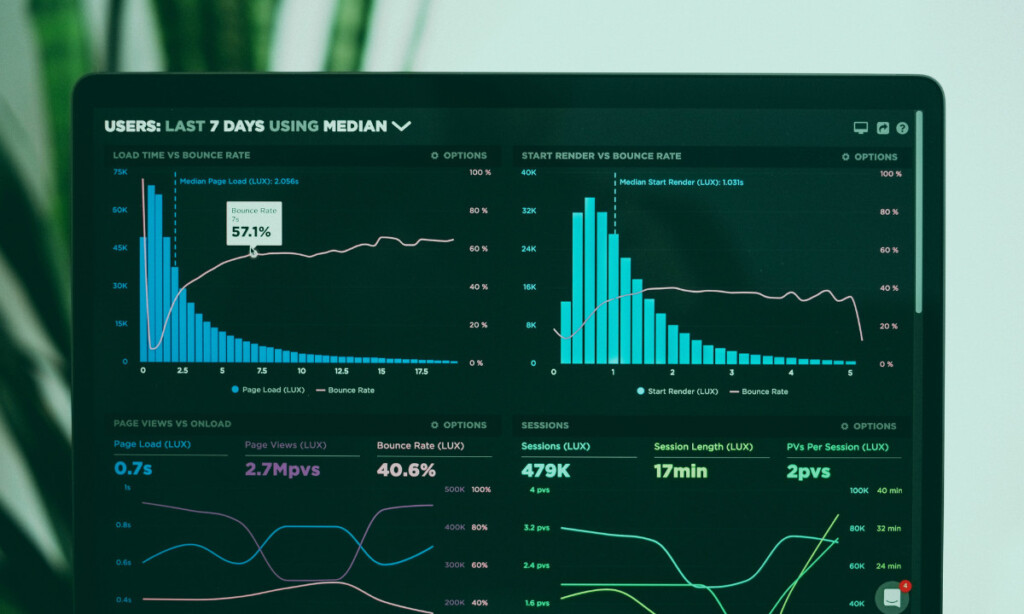- Here are my top picks for Amplitude alternatives:
- What you should look for in a Product Analytics tool:
- Here are my top alternatives to Amplitude
- Pendo - Best alternative for optimizing customer experience
- Heap - Best alternative for digital insights and visual data representation
- Mixpanel - Best easy-to-use and cost-effective alternative
- Statsig - Best alternative for experimentation and feature management
- UXCam - Best mobile-focused alternative
Last Updated on September 5, 2025 by Ewen Finser
While Amplitude is an excellent tool with some advanced features, it might not be the best fit for all organizations. As a small or scaling business, the pricing tends to be restrictive, and costs are hard to contain. There are several other options out there that are strong alternatives for companies that may be looking to make a change.
Here are my top picks for Amplitude alternatives:
- Pendo – Best alternative for optimizing customer experience
- Heap – Best alternative for digital insights and visual data representation
- Mixpanel – Best easy-to-use and cost-effective alternative
- Statsig – Best alternative for experimentation and feature management
- UXCam – Best mobile-focused alternative
When looking at choosing a product analytics platform, you’ll need to consider each tool’s core capabilities and why it’s a good fit for your organization or product team. Product analytics platforms should be able to help you not only track key metrics but also understand user behavior in an in-depth way.
By being able to understand how users interact with your software, you can identify gaps, pain points, inefficiencies, or bugs quickly so that you can make corrective changes. However, the real power comes from being able to analyze user behavior to identify opportunities and enhance software in a way that helps to drive better adoption and increase revenue.
While these platforms have their own unique selling points, here are a few core functionalities that should be at the forefront when considering tools specifically for product analytics.
What you should look for in a Product Analytics tool:
- Ease of use – first and foremost, your product team needs to be able to set up the tool easily and configure it in a way that makes it a great fit for your organization’s needs.
- Holistic tooling – Software that combines multiple functions is becoming increasingly more important in recent times. Product Analytics tools should not only measure key metrics, but also be able to play various roles, such as product development, testing, and even assist with governance.
- Event tracking – User behavior is a critical measure when analyzing how effectively your software is performing. Ensuring you’re able to measure this through event tracking, such as clicks, transactions, or page views, is vital.
- Segmentation – Having ways to segment your audience or user base is essential, especially when it comes to specific features.
- Experimentation and testing – A/B, multivariate, or more advanced experimentation features are critical for safe and successful deployments.
- Feature flagging – feature flagging or feature management is critical to ensure gradual and safe feature rollouts can be easily managed and measured by product teams.
- Analytics & reporting – A great product analytics tool should be able to deliver in-depth insights into multiple aspects, features, including outputs from experimentation, user behavior, and more. Ideally, these should be surfaced automatically and in a way that is easy to interpret by multiple stakeholders.
Here are my top alternatives to Amplitude
When comparing alternatives, look out for specific features that may be important for your team and why each may potentially be a good fit.
Pendo – Best alternative for optimizing customer experience
Pendo prides itself on being a “software experience management platform” (or SXM) more than just a product management tool. Being a no-code software optimized for tracking user behavior, it excels in understanding customer experience by gathering user feedback, in-app guidance, and roadmapping.
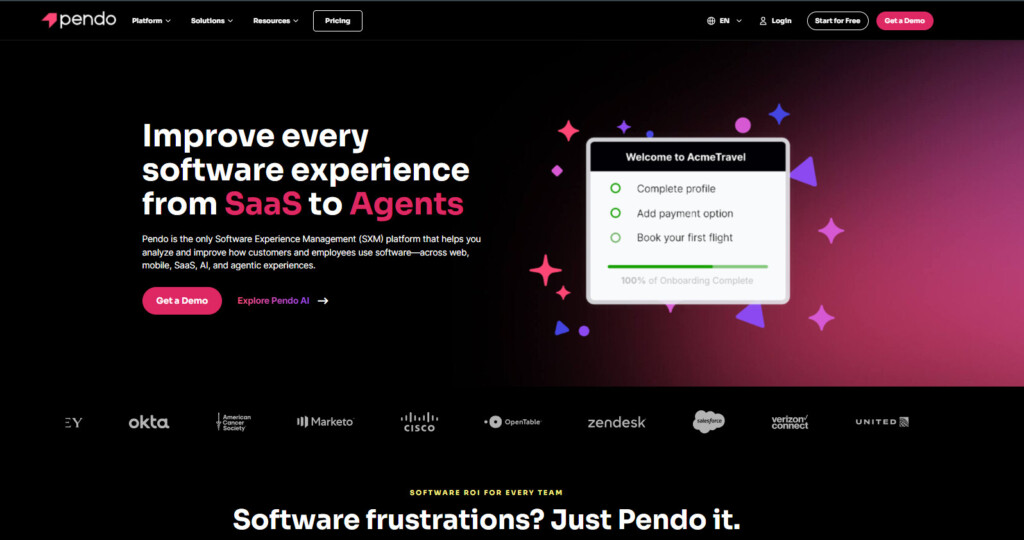
Standout features of Pendo
- Pendo NPS helps you understand user sentiment. NPS (or net promoter score) is an important and valuable way to measure how users feel and interpret your software.
- Pendo session replays allow you to visualize how users are interacting with your software. Having access to unlimited replays is a great value add, allowing you to drill into trends and analyze where users are experiencing friction.
- Pendo guides, listens, and orchestrates user journeys and onboarding. Pendo allows you to create customized in-app guides and walkthroughs.
Why it’s a good alternative to Amplitude
- While Amplitude’s strengths lie in being able to provide analytics around user behavior, it can lack in helping teams interpret the data and understand how to act on it.
Pricing
- Pricing is not publicly available and is available upon request only.
- Pendo has four pricing plans to choose from.
- Free trial available
Heap – Best alternative for digital insights and visual data representation
Heap is a digital insights platform that excels in visualizing data in a way that helps organizations understand how users interact with their product.
Heap is an excellent option for organizations needing a straightforward way to create events on the fly and collect insights into customer behavior to drive improvements in their business.
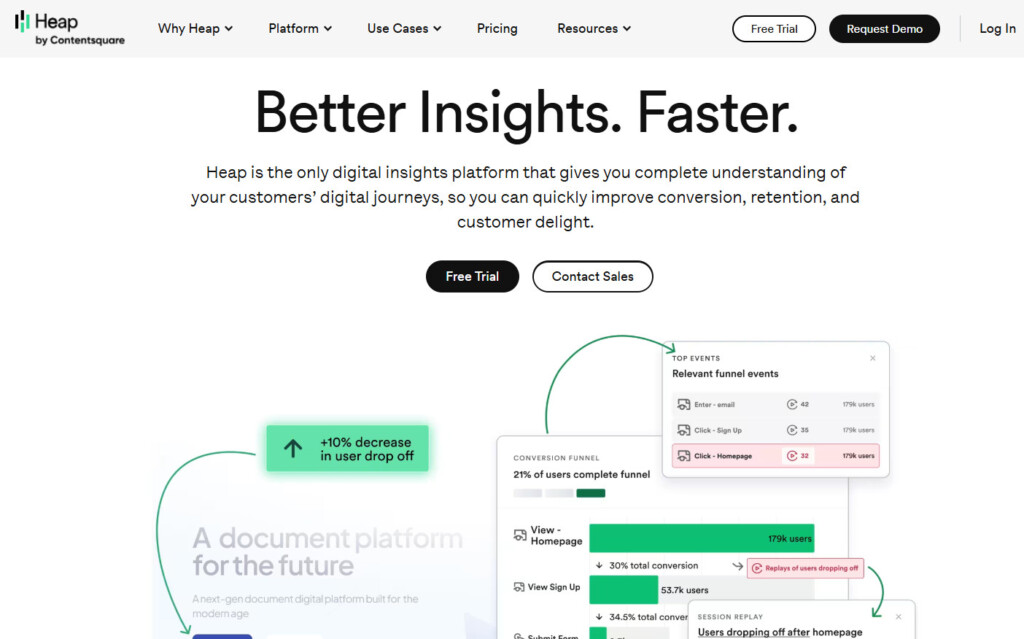
Standout features of Heap
- Smart Capture is an advanced feature on Heap that allows automated data capture to run without advanced configuration upfront—automatically capturing user behavior across both web and mobile. Smart Capture exposes valuable insights to product teams who may have missed creating tags to monitor important user behavior and engagement.
- Smart Capture is particularly powerful for users who need to analyse data and specified events retrospectively. Retroactive analysis is useful when needing to measure specific metrics that you hadn’t tagged previously. These insights are already tracked automatically with Smart Capture so that key details can be analyzed.
- Dashboard and insights into product analytics offer valuable insights in a way that stakeholders can easily interpret. Dashboards are a powerful way to surface important information for easy retrieval without needing to set up charts and graphs from scratch.
- Heap also allows users to pull real-time insights, helping to measure user behavior as it happens. This is beneficial so that product teams can make changes proactively before issues become pain points for users.
Why it’s a good alternative to Amplitude
- Where Amplitude requires a lot of configuration upfront, Heap can automatically capture events such as clicks, session replays, and more. Heap also has baked-in charts and reports that don’t require configuration ahead of time.
- Heap has a quick onboarding and doesn’t require extensive setup to get up and running. It’s also simple enough for non-technical users to use, making it ideal for lean teams that need a shorter implementation process.
Pricing
- Pricing is not publicly available and is available upon request only.
- Heap has four pricing plans to choose from.
- Free plan available, which includes access to analytics, up to 10,000 monthly sessions, and more.
- Free trial available on the Pro plan (lowest of the paid tiers) only.
Mixpanel – Best easy-to-use and cost-effective alternative
Mixpanel is an intuitive and user-friendly platform that is an excellent option for smaller teams and organizations that need an affordable and easy-to-use product analytics platform.
Mixpanel has a lot of the same features that some of the more expensive tools have, but with a lower cost and slightly lower learning curve, making it a great fit for startups and SMBs.
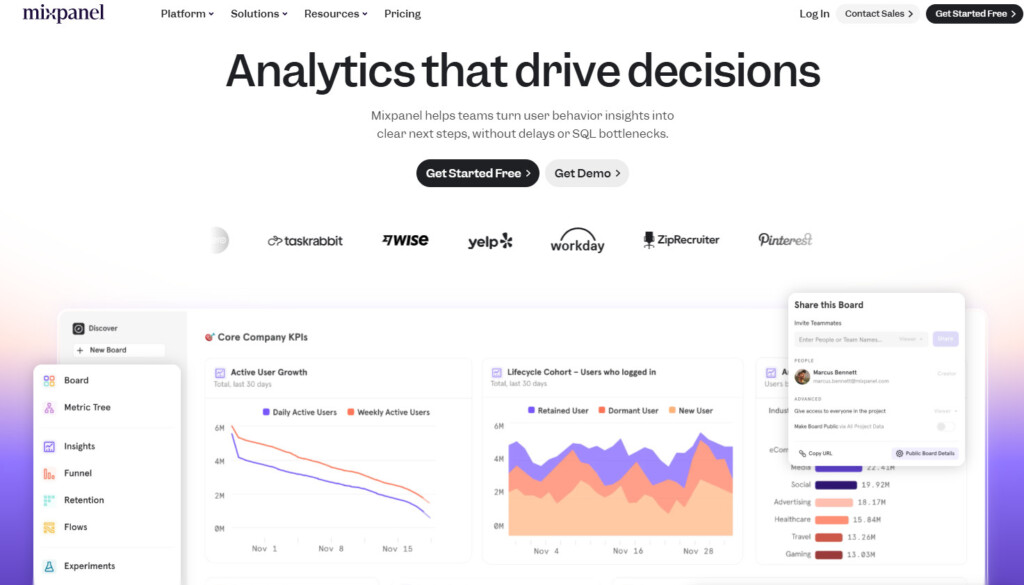
Standout features of Mixpanel
- Mixpanel’s main selling point is its ease of use and intuitive UX, which seems to stand out compared to other tools, including Amplitude. For smaller teams that have fewer technical users, Mixpanel may be a great alternative.
- Intuitive analytics and real-time event-tracking help teams easily surface insights into complex data and user interactions.
- Unlimited funnel set-ups, product teams can gain insights into user behavior, such as drop-offs and other key metrics related to user journeys.
- Retroactive analysis (similar to Heap) allows you to delve into metrics around user behavior that has already occurred, meaning that you don’t need to configure specific actions and rerun reports.
Why it’s a good alternative to Amplitude
- Mixpanel is easy to use and generally requires less advanced technical onboarding than Amplitude, which means it’s a better fit for smaller companies that need a less complex solution.
- Pricing is more cost-effective with options to scale as your business grows.
Pricing
- Mixpanel has three pricing tiers available, including a free plan, which includes up to 1million monthly events, reports, and 10,000 session replays.
- Mixpanel has a mid-level tier with pricing that ranges up to $2,289.00 per month, with discounts offered for monthly billing.
- The enterprise tier has custom pricing available upon request.
Statsig – Best alternative for experimentation and feature management
Statsig is a powerful product analytics platform that combines key features such as experimentation, feature flagging, analytics, and more into one platform. Statsig is an ideal fit for startups through to enterprise-level organizations that need ways to manage safe and gradual feature rollouts as well as analyze key data with ease.
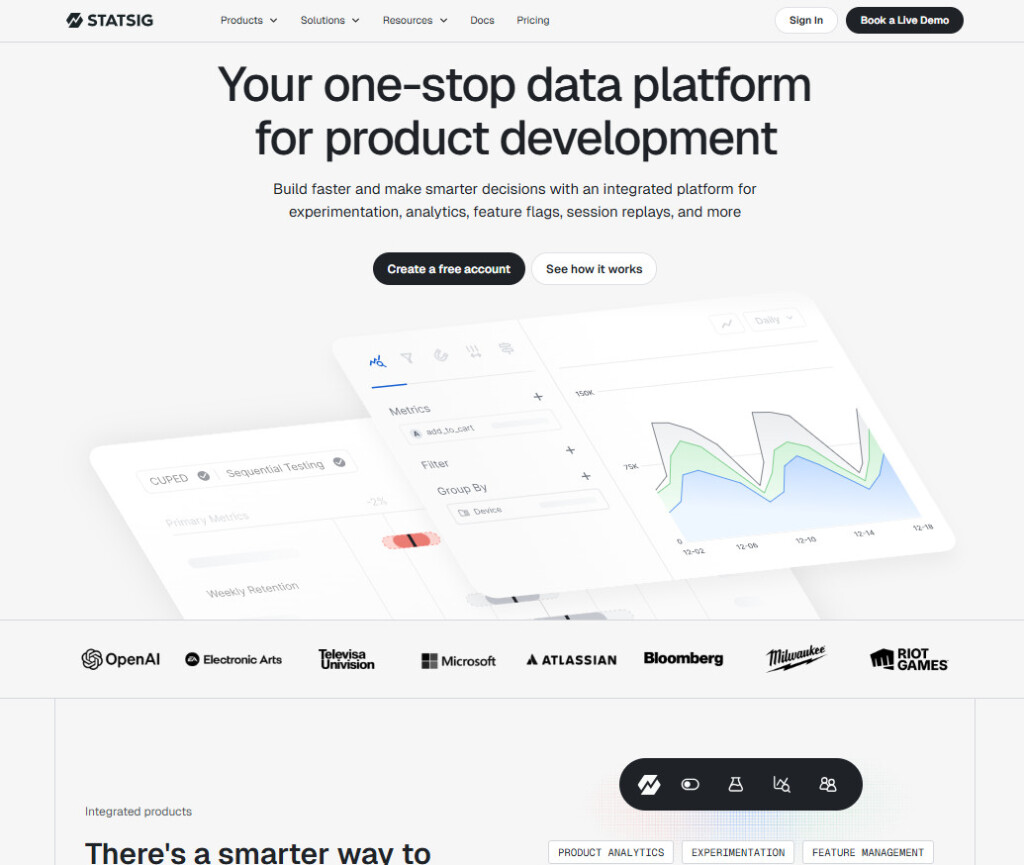
Standout features of Statsig
- Advanced experimentation features – This includes A/B/n, Bayesian, sequential, and multi-armed bandit experiments, and more. Advanced experimentation features allow product teams to run hundreds of concurrent tests without disrupting users and to analyze the data all in one place.
- Session replays – With the ability to run multiple session replays, organizations can analyse how users are interacting with the product, see where the pain points are, and make necessary changes to improve the user experience. This helps drive better adoption and also exploits potential opportunities to drive revenue.
- Feature flagging and management – Having the flexibility and control of segmenting features with an easy toggle on/off is a standout feature of Statsig. Converting flags into experiments gives product teams an edge into understanding and analyzing specific features and user impact without needing to use multiple tools. As an added bonus of this feature, Statsig offers generous plans that include unlimited flags.
- User journey mapping – User journey mapping is a critical tool in understanding how users interact with your product.
Statsig’s user path analysis helps understand user behavior so that product teams use analytics around feature impact to drive better decisions. - User journey mapping coupled with session replay is a powerful way to really understand both qualitative and quantitative data. Key data outputs help product teams understand how to drive retention and ultimately revenue in a positive direction.
Why it’s a good alternative to Amplitude
- Where other platforms like Amplitude fall short, Statsig really excels in offering teams ways to thoroughly and safely, and rapidly experiment and test their product.
- With feature management, experimentation, and product analytics rolled into one tool, Statsig really stands out. Statsig is an excellent alternative for product teams wanting to get away from disparate systems and processes that require them to stitch together key features such as experimentation and feature flagging.
Pricing
- Statsig has three pricing plans, which include a generous free plan.
- The free plan which includes access to up to 2M events per month, 50,000 session replays, basic experimentation, and feature management.
- The mid-level tier starts at $150 per month, and the enterprise level plan has custom pricing available upon request.
UXCam – Best mobile-focused alternative
UXCam is a great product for mobile-first teams that need to quickly and effectively monitor user behavior and interactions. UXCam leverages session replays, heatmaps, funnel analysis, and tracking to offer in-depth insights into user interactions with mobile apps.
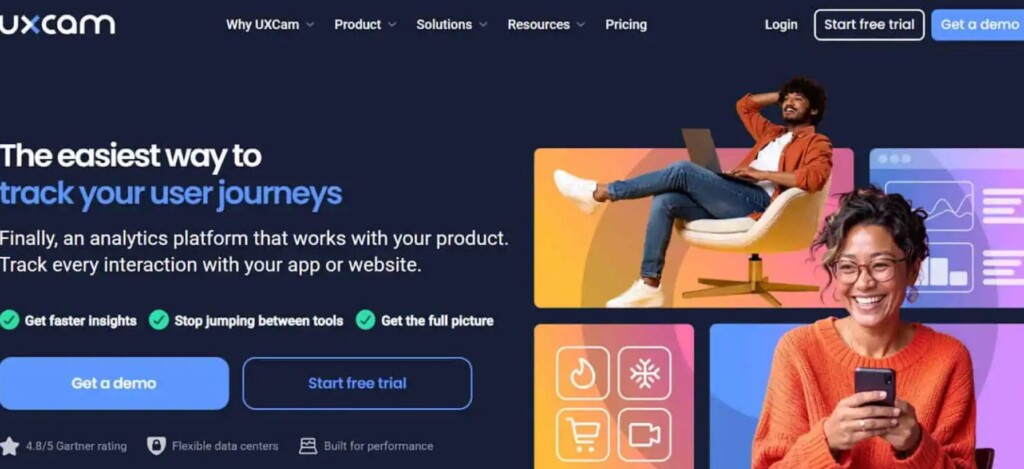
Standout features of UXCam
- Mobile-first analytics and UX insights set UXCam apart from tools like Amplitude. UXCam has a great, lightweight SDK solution that tracks user interaction on mobile apps by using heatmaps and session replays to display metrics in a visual way.
- Visual insights are a great way to have various stakeholders, even those who are less technical, easily interpret user patterns so that key points of friction can be identified quickly and resolved before they become pain points.
- Lightweight deployment and configuration make UXCam an excellent option for smaller teams or startups that need to get up and running quickly.
Why it’s a good alternative to Amplitude
- Tracking swipes, delays, taps, and general user gestures, teams can surface and add a layer of interaction that other tools, like Amplitude, are not able to do.
- Where Amplitude excels in advanced overall product analytics, it lacks in advanced UX insight across mobile apps. UXCam also requires less advanced onboarding and setup time compared to Amplitude.
- UXCam has a great free plan available, which makes it a cost-effective and scalable option for startups or smaller companies.
Pricing
- UXCam has three pricing tiers available, including a free plan.
- The free plan includes up to 3,000 monthly sessions, basic filters, session replays, and more.
- Other plans (three to choose from) don’t have transparent pricing plans, and pricing is available upon request only.
Choosing a tool from the various options out there can be overwhelming. The best fit for you will ultimately come down to what your needs are when it comes to selecting a product software platform that addresses your needs. First, consider what pain points you’re trying to solve, how you intend to use the platform, cost implications, and your team’s abilities so that you can choose the best fit for your organization.
Based on the above, here are my recommendations for product fit:
- Pendo is the best alternative for organizations that are focused on user adoption. With a strong focus on customer experience, Pendo has multiple tools to gauge user sentiment.
- Pick Heap if you need an alternative that leverages flexible and digital insights with minimal configuration requirements.
- Mixpanel is a great alternative for cost-conscious teams who need a user-friendly platform with built-in messaging and real-time reporting capabilities.
- Choose Statsig if you need an option with transparent pricing, advanced experimentation, feature flags, and an all-in-one tool that can adapt to your requirements as your business scales.
- UXCam is the best mobile-focused alternative that can quickly and easily analyze user interaction to easily and visually expose user friction and interaction with mobile apps.

